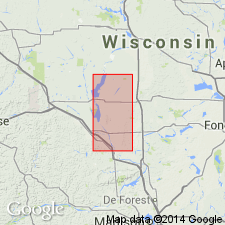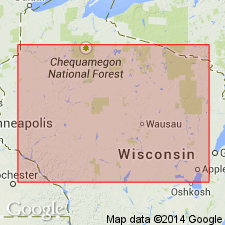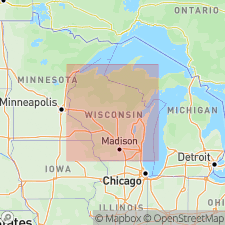
- Usage in publication:
-
- Big Flats Formation
- Modifications:
-
- Areal extent
- AAPG geologic province:
-
- Wisconsin arch
Summary:
The New Rome Member (Brownell, IN Attig and others, in press) is included in both the Horicon and Big Flats Formations, where it consists of silt and clay underlying the surface sand of both formations. The New Rome is assigned to the Horicon in the northeast part of Adams County and eventually pinches out in Portage County. Member thickens to the south through Wood, Juneau, and Sauk Counties where it is assigned to the Big Flats Formation. In Adams County, the Big Flats was deposited about the same time as the Horicon Formation.
Source: GNU records (USGS DDS-6; Reston GNULEX).

- Usage in publication:
-
- Big Flats Formation
- Modifications:
-
- Principal reference
- Dominant lithology:
-
- Sand
- Silt
- Clay
- AAPG geologic province:
-
- Wisconsin arch
Summary:
Pg. vi (chart), 19-22. Big Flats Formation. (Follows the informal usage of Jim Brownell, 1986, Univ. Wisconsin MS thesis.) Lake and stream sediments. Chiefly beds of moderately well-sorted to well-sorted, noncalcareous sand. Commonly includes angular dark-colored grains. Thickness up to 40+ m; generally is 1 to 10 m. Includes New Rome Member (new). Is typically a surface unit; overlies Cambrian or older formations, or sand of Copper Falls or Horicon Formations. Upper part deposited about 20,000 to 13,000 yr B.P. (last part of Wisconsin Glaciation). Lower part may have been deposited during early part of Wisconsin Glaciation, or pre-Wisconsinan. Age is considered Pleistocene (Wisconsinan).
Type section (subsurface): drillhole located in the unincorporated community of Big Flats, 100 m east of State Highway 13 on County Trunk Highway C, in NW/4 NW/4 NE/4 sec. 20, T. 19 N., R. 6 E., [approx. Lat. 44 deg. 06 min. 42 sec. N., Long. 89 deg. 48 min. 22 sec. W.], Roche A Cri 7.5-min quadrangle, Adams Co., central WI. Named from Big Flats Twp., Adams Co., central WI; name credited to Jim Brownell.
[Additional locality information from USGS historical topographic map collection TopoView and Wisconsin Highways, www.wisconsinhighways.org; accessed on June 9, 2018.]
Source: Publication.

- Usage in publication:
-
- Big Flats Formation
- Modifications:
-
- Overview
- AAPG geologic province:
-
- Wisconsin arch
Summary:
[Not synopsized to date. Lithology, thickness, distinguishing characteristics, contacts, sections, areal extent, age, correlations discussed.]
Pg. 4 (fig. 2), 7 (fig. 3), 8, 111-114. Big Flats Formation. Incl. New Rome Member.
Source: NA
For more information, please contact Nancy Stamm, Geologic Names Committee Secretary.
Asterisk (*) indicates published by U.S. Geological Survey authors.
"No current usage" (†) implies that a name has been abandoned or has fallen into disuse. Former usage and, if known, replacement name given in parentheses ( ).
Slash (/) indicates name conflicts with nomenclatural guidelines (CSN, 1933; ACSN, 1961, 1970; NACSN, 1983, 2005, 2021). May be explained within brackets ([ ]).

